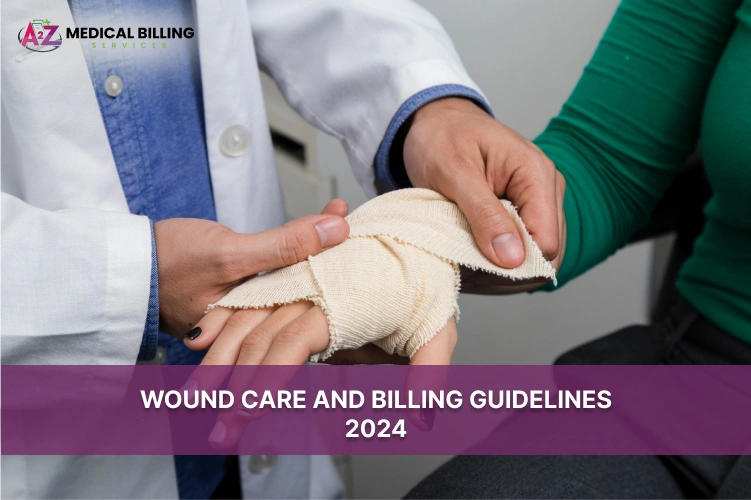Proficiency in the many types of wounds, the phases of wound healing, and the range of treatment alternatives are essential for medical coding in the complex field of wound care.
Healthcare professionals need to be aware of how to get paid appropriately when it comes to wound care billing and coding.
Knowing the challenges of keeping up with code changes and how they impact payment methods is essential for someone who specializes in medical billing. The necessity of putting in place precise and up-to-date billing methods is highlighted by these developments. To optimize reimbursement while upholding compliance, this blog aims to provide a comprehensive and lucid explanation of wound care coding and billing procedures.
Wound Care Coding and Billing Guidelines
Precision Is Key: To appropriately reflect the treatment given, each wound care service must be coded with the highest precision. This covers particular codes for the kind of wound, where it is, and what kind of therapy is being used.
Documentation Matters: The coding decisions are supported by sufficient documentation, guaranteeing that the claims are supported by clinical evidence. This contains thorough notes on the extent, depth, and healing course of the wound.
Importance of Staying Updated with the Latest Guidelines
Regulatory Compliance: Billing and coding rules are subject to regular revision. It’s essential to stay up to date on updates if you want to comply and prevent denials.
Improved Reimbursement: Staying up to date on guidelines will help you find new ways to charge and enhance your coding techniques, which will increase your reimbursement.
How Higher Reimbursement Rates Can Be Achieved with Accurate Coding
Minimize Claim Denials: The likelihood of claim denials is decreased by precise and detailed coding. More steady revenue is the result of fewer denials.
Maximize Revenue: Effective coding can reveal unused billing opportunities, which has a favorable immediate influence on the bottom line.
Techniques for Achievement
Ongoing Education: Consistent instruction and updates on the most recent guidelines for the coding team are necessary to achieve the desired results.
Make Use of Technology: Make use of billing and coding software that is updated frequently to conform to the most recent coding standards.
Impact of Accurate Coding on Reimbursement
| Factor | With Accurate Coding | With Inaccurate Coding |
| Claim Denials | Reduced | Increased |
| Reimbursement Rates | Improved | Compromised |
| Compliance | High | Low |
| Revenue Optimization | Yes | No |
Understanding the Wound Washout CPT Code
An important step in wound care is wound washout, which involves cleansing a wound to keep it clean and encourage healing. For proper billing and reimbursement, this procedure must be coded correctly.
Explanation of the CPT Code for Wound Washout
Watering, or wound washing, is an essential component of wound care. The manner and difficulty of the procedure determine the appropriate CPT code. Usually, it comprises:
97597: Non-selective cleaning (removal of devitalized tissue from wounds, usually used for simple washouts). When non-viable tissue needs to be removed during a process without requiring a more disruptive surgical method, this code is relevant.
When to Use This Code in Clinical Practice
In various therapeutic settings, it is imperative to utilize the appropriate CPT code for wound washing.
Presence of Debris or Infection: If a wound is infected or polluted with foreign material, the presence of debris or infection is necessary.
After Initial Injury: To clean wounds as soon as possible after an injury.
Before Closure Procedures: A portion of the actions taken in advance of surgery to close a wound or perform additional procedures.
Tips for Documentation to Support Billing
In order to justify wound washout billing, proper documentation is essential. Crucial elements consist of:
Explain the process: Give a clear explanation of why a wound washing is necessary, mentioning clinical reasons such as debris, infection, or the state of the wound.
Describe the procedure in detail: To support the selected CPT code, keep records of the washout procedure, solutions used, and any anesthetic administered.
Dimensions and Images: Provide measurements of the wound and pictures taken both before and after the procedure, if feasible, to support the need and result.
Patient Response: Take note of any quick responses the wound has to the washout, as this will demonstrate how well the operation was.
Documentation Checklist for Wound Washout Billing
Ensure your documentation is comprehensive by including:
| Documentation Element | Description |
| Procedure Necessity | Justify the need for wound washout, highlighting clinical reasons. |
| Procedure Details | Enumerate the method, solutions, and anesthesia used. |
| Wound Measurements | Provide dimensions of the wound pre- and post-washout. |
| Photographic Evidence | Attach before and after photos, if available. |
| Patient Response | Document the wound’s immediate response to treatment. |
Wound Care Coding Cheat Sheet: Essential for Fast-Paced Billing Environments
Having fast, trustworthy references available is not only helpful, but necessary in the fast-paced world of medical billing and coding. This is especially true in the specialty area of wound care, where accurate coding has a big influence on payment amounts. We’ve put up a condensed cheat sheet for frequently used wound care codes to help consultants, billers, coders, and healthcare workers. This tool is intended to expedite the coding procedure and guarantee precision and effectiveness in billing procedures.
The Value of Instant References
In the busy world of healthcare, time is critical. Coding cheat sheets and other quick reference materials can significantly cut down on the amount of time spent looking up codes, enabling:
Enhanced Productivity and Workflow: Having instant access to codes improves productivity.
Accuracy: lowers the possibility of coding errors, which prevents denials and rejections of claims.
Education: Serves as a learning aid for recently hired employees, gradually enhancing their coding competence.
Wound Care Coding Cheat Sheet
A cheat sheet with common wound care CPT codes and their descriptions can be found below. In order to make sure that medical billers and coders can locate and use the most accurate codes for wound care procedures quickly, this cheat sheet acts as a reference.
| CPT Code | Description |
| 97597 | Removal of devitalized tissue from wound(s), non-selective debridement, first 20 cm2 or less |
| 97598 | Each additional 20 cm2, or part thereof (listed separately in addition to code for primary procedure) |
| 11042 | Debridement, subcutaneous tissue (includes epidermis and dermis, if performed); first 20 cm2 or less |
| 11043 | Debridement, muscle, and/or fascia (includes epidermis, dermis, and subcutaneous tissue, if performed); first 20 cm2 or less |
| 11044 | Debridement, bone (includes epidermis, dermis, subcutaneous tissue, muscle, and/or fascia, if performed); first 20 cm2 or less |
| 16020 | Dressings and/or debridement of partial-thickness burns, small (less than 5% total body surface area) |
| 16025 | Dressings and/or debridement of partial-thickness burns, medium (5% to 10% total body surface area) |
| 16030 | Dressings and/or debridement of partial-thickness burns, large (more than 10% total body surface area) |
Understanding the CPT Code for Debridement of Wound
Understanding the particulars of CPT codes related to wound debridement is essential for accurate billing and reimbursement in the context of wound care.
Detailed Examination of the Wound Debridement-Related CPT Codes
In order to facilitate healing, debridement of the wound is a crucial procedure that eliminates foreign objects, dead tissue, and debris. The CPT code selection is influenced by the area treated, the extent of debridement, and the complexity of the wound. For easy reference, use this:
11042: Debridement, subcutaneous tissue (includes epidermis and dermis, if performed); first 20 sq cm or less.
11045: Each additional 20 sq cm, or part thereof (use in conjunction with 11042).
11043: Debridement, muscle, and/or fascia (includes epidermis, dermis, and subcutaneous tissue, if performed); first 20 sq cm or less.
11046: Each additional 20 sq cm, or part thereof (use in conjunction with 11043).
11044: Debridement, bone (includes epidermis, dermis, subcutaneous tissue, muscle, and/or fascia, if performed); first 20 sq cm or less.
11047: Each additional 20 sq cm, or part thereof (use in conjunction with 11044).
Guidelines on Using These Codes Accurately in Billing
Take into account the following recommendations to guarantee correct billing for wound debridement:
Establish the Depth of Debridement: To choose the right code, precisely determine and record the depth of debridement (subcutaneous tissue, muscle/fascia, or bone).
Calculate the Area: Accurately calculate the debridement area in square centimeters. The stated size must be supported by documentation.
Use Add-on Codes Correctly: Use the relevant add-on codes for each additional 20 sq cm, or portion of an initial 20 sq cm, of debridement. The primary debridement code must be used in conjunction with these.
Record clearly: The extent of tissue removed, the size of the wound both before and after debridement, and a thorough explanation of the debridement treatment should all be included in the documentation.
Procedure Code for Wound Care
Wound care management is a complicated area of healthcare services that requires precise coding to enable effective billing and payment. This comprehensive guide looks into the procedure codes often utilized in wound care, explaining their significance in the billing method and their impact on remuneration.
An Explanation of Procedure Codes Often Used in the Management of Wounds
The main source of procedure codes for wound care is the Current Procedural Terminology (CPT) system. The many treatments and procedures that a patient has had are listed in these codes. Among the key codes are:
Debridement Codes (11042-11047): These codes range based on the depth of tissue removed (subcutaneous, muscle/fascia, bone) and the size of the area debrided.
Skin Substitute Grafts (15271-15278): These codes are used for wounds requiring skin substitute grafts, varying by the size of the wound and the location.
Negative Pressure Wound Therapy (NPWT) (97605, 97606): Codes for services involving the application of sub-atmospheric pressure to a wound to assist in healing.
Wound Dressings (A6216-A6256): While not CPT codes, these HCPCS codes cover specific types of wound dressings.
| Code Range | Description | Application |
| 11042-11047 | Debridement based on depth and area | Removal of non-viable tissue |
| 15271-15278 | Skin substitute grafts | Covering and protecting wounds |
| 97605, 97606 | NPWT | Promoting wound healing |
| A6216-A6256 | Wound dressings | Covering and managing wound sites |
The Role of These Comuscle, the Billing Process and How They Affect Reimbursement
Procedure codes are essential to the medical billing process because they act as a common language for insurance companies and healthcare providers. They have various effects on reimbursement:
Accuracy and Specificity: To accurately express the wound care services provided, precise coding is necessary. Underpayment or rejection of a claim may result from inaccuracies.
Proof of Medical Necessity: Codes attest to the wound care’s medical necessity, which makes insurance companies more likely to approve it.
Reimbursement Rates: The rates of reimbursement for various codes vary. Making the right code choice guarantees that healthcare professionals receive fair compensation for the quality of treatment they offer.
Compliance: Precise coding reduces the possibility of audits by guaranteeing compliance with payer policy and healthcare standards.
Wound Care Coding Guidelines: Ensuring Accuracy and Compliance
Careful consideration must be given to wound care coding in order to guarantee accuracy and adherence to medical billing guidelines. Healthcare workers can lower audit risks and increase reimbursement by following certain coding norms.
Specific Coding Guidelines for Wound Care
Select the most precise and detailed CPT codes for the wound care treatments carried out, taking into account the size of the wound, the kind of closure or dressing used, and the depth and extent of debridement.
Documentation: Keep thorough records that specify the technique done, the supplies used, and the wound’s location, size, and depth. The codes selected should be supported by this documentation.
Use of Modifiers: When describing operations that are bilateral, multiple, or involve particular situations, use the relevant modifiers.
Minimizing Compliance and Audit Risk
Audit risks and compliance can be minimized by:
Education: Provide regular updates on the most recent CPT codes and recommendations for wound care to the coding team and healthcare practitioners.
Audit Trails: To support the codes billed, provide clear, comprehensive audit trails in medical records.
Quality Control: Conduct periodic internal audits to guarantee compliance and the correctness of coding.
By following these recommendations, wound care billing best practices can be aligned, resulting in claims that are precise, compliant, and appropriately reflect the services provided. This maintains the billing process’s integrity and helps the practice stay financially stable by lowering the risk of audits and denials.
Medicare Wound Care Billing: Essential Information
Healthcare professionals must be aware of Medicare’s wound care billing regulations in order to guarantee compliance and obtain appropriate payment. This is a concise summary of Medicare’s billing guidelines, along with advice on how to stay out of trouble.
Overview of Medicare’s Policies on Wound Care Billing
An overview of Medicare’s policies on the billing of wound care and adherence to correct coding Medicare requires that International Classification of Diseases (ICD-10) and Current Procedural Terminology (CPT) codes accurately reflect the particular services rendered.
Documentation Is Essential: Medicare requires thorough records that explain the wound in great detail, the care that was given, and the reasoning behind the treatment plan that was selected.
Coverage Guidelines: To make sure services are covered, familiarize yourself with Medicare’s coverage for various wound care services, such as debridement, dressing changes, and the use of skin substitutes.
Typical Traps to Avoid and Ensuring Compliance
Unbundling and Upcoding: Steer clear of billing services separately that should be included together or incorrectly coding for more complicated services than given; these actions may lead to audits.
Timeliness: In order to prevent Medicare claim denials for late submission, submit your claims by Medicare’s deadlines.
Remain Up to Date: Keep up with Medicare’s evolving rules and regulations on a regular basis to ensure compliance and streamline billing procedures.
Wound Care Billing and Coding Services: Enhancing Your Practice
By optimizing reimbursement and streamlining operations, wound care organizations can greatly benefit from outsourcing billing and coding services.
Advantages of Contracting Out Coding and Billing Services
Enhanced Accuracy: By ensuring correct and current coding, specialists lower the number of claim denials.
Time and Cost Efficiency: It can be less expensive than handling in-house billing and relieves internal staff of some of their responsibilities, enabling them to concentrate on patient care.
Compliance: Maintaining your practice in compliance with healthcare laws and regulations requires knowledge of regulatory developments.
What to Look for in a Reputable Service Provider of Coding and Billing
Proficiency in Wound Care: Acquired expertise in wound care billing and coding to provide tailored recommendations.
Transparency: reporting on billing procedures and results, as well as clear communication.
Technology: For accuracy and efficiency, advanced billing software is used.
Reputation: satisfied client feedback and a history of increasing billing results.
Medicare Wound Care Billing: Essential Information
It’s important to comprehend Medicare’s wound care billing guidelines and steer clear of frequent mistakes.
An overview of Medicare’s billing policies for wound care
Correct Coding: Complying with the CPT and ICD-10 coding requirements as specified by Medicare.
Requirements for documentation: comprehensive records supporting the given care.
Typical Traps to Avoid and Ensure Adherence
Preventing Wrong Coding: Make sure the codes appropriately indicate the services rendered.
On Time Submission: Respect Medicare’s guidelines for submission dates.
Stay Updated: Review Medicare guidelines often to stay up to date on any changes.
Knowing these aspects is essential for accurate and timely Medicare billing, maintaining the practice’s financial stability, and guaranteeing that patients obtain their rightful benefits.
Let’s Recap:
To summarize, the search for excellence in wound care billing and coding is an ongoing process that necessitates focus, commitment, and flexibility. Healthcare providers may optimize their reimbursement and, more crucially, concentrate their time and attention on giving their patients the best care possible by focusing on correct billing procedures and promoting a culture of ongoing learning. The success of wound care services in the current healthcare environment will be largely determined by this dedication to both clinical and financial excellence.



